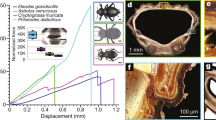Abstract
WE describe here a debonding mechanism for interfaces between dissimilar materials in conditions of dynamic loading, and we deal, in particular, with coated substrates that are impacted by solid or liquid projectiles. Protective coatings are commonly used to enhance the resistance of materials to impact erosion; for example, non-metallic fibre-reinforced composite materials are found to be very susceptible to impact erosion unless a suitable thin coating is applied. For these composites, certain elastomers can be successful as coating materials, even though they do not, intrinsically, possess high strength. Coatings of this type reduce the pressures that are transmitted to the substrate by presenting a lower dynamic impedance to the impacting body. The interfacial adhesion between the coating and substrate is of great importance because it enables the substrate to reinforce the coating by restricting the lateral strain, and therefore the stress, within the coating. When adhesion is lost, the coating itself becomes quickly eroded. Thus, the bond between the coating and substrate is often of great significance to the success of a coating–substrate system.
This is a preview of subscription content, access via your institution
Access options
Subscribe to this journal
Receive 51 print issues and online access
$199.00 per year
only $3.90 per issue
Buy this article
- Purchase on Springer Link
- Instant access to full article PDF
Prices may be subject to local taxes which are calculated during checkout
Similar content being viewed by others
References
Engel, O. G., W.A.D.C. Tech. Rep. TR53–192, pt.X. (1957).
Conn, A. F., and Thiruvengadam, A., J. Mater. JMSLA, 5, 3, 698–713 (1970).
Field, J. E., Camus, J.-J., and Gorham, D. A., Proc. 3rd Int. Conf. on Rain Erosion and Allied Phenomena, RAE, Farnborough, 303–324 (RAE Farnborough, 1970).
Gorham, D. A., Proc. 10th Int. Cong. on High-speed Photography, Nice, 438–444 (Association Nationale de la Recherche Technique, Paris, 1972).
Gorham, D. A., thesis, Univ. Cambridge (1974).
Kolsky, H., Stress Waves in Solids (Clarendon, Oxford, 1953).
Bowden, F. P., and Brunton, J. H., Proc. R. Soc., A 263, 433–450 (1961).
Gorham, D. A., and Field, J. E., Proc. llth Int. Congr. on High-speed Photography, London, 442–447 (1974).
Ewing, W. M., Jardetsky, W. S., and Press, F., Elastic Waves in Layered Media (McGraw-Hill, New York, 1957).
Cagniard, L., Reflection and Refraction of Progressive Seismic Waves (McGraw-Hill, New York, 1962).
Daniel, I. M., and Marino, R. L., Exp. Mech., 11, 210–216 (1971).
Burger, C. P., and Riley, W. F., Exp. Mech., 14, 129–137 (1974).
Davids, N., Fibre Sci. Tech., 1, 113–121 (1968).
Chou, P. C., and Wang, A. S. D., J. compos. Mater., 4, 444–461 (1970).
Author information
Authors and Affiliations
Rights and permissions
About this article
Cite this article
GORHAM, D., FIELD, J. Mechanism for shear delamination under dynamic loading. Nature 257, 216–217 (1975). https://doi.org/10.1038/257216a0
Received:
Accepted:
Issue Date:
DOI: https://doi.org/10.1038/257216a0
Comments
By submitting a comment you agree to abide by our Terms and Community Guidelines. If you find something abusive or that does not comply with our terms or guidelines please flag it as inappropriate.



